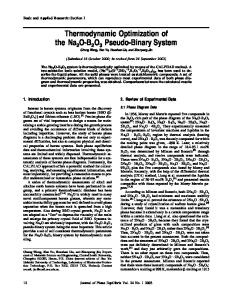Critical Evaluation and Thermodynamic Optimization of the Na 2 O-FeO-Fe 2 O 3 System
- PDF / 1,517,470 Bytes
- 19 Pages / 593.972 x 792 pts Page_size
- 65 Downloads / 339 Views
I.
INTRODUCTION
THE Na2O-FeO-Fe2O3 system is important for various industrial applications. In the blast furnace of ironmaking process, the presence of alkali metals like Na and K can result in the accretion of alkali-rich oxides which damages the blast furnace refractory and disintegration of pellets and coke during the ironmaking process.[1,2] In the cooling system of fast breeder reactors, the corrosion of steel liners happens by the oxygen contaminated sodium with the formation of Na-Fe-O type oxides.[1–6] The recent bioactive glass ceramics contain a considerable amount of Na2O, FeO, and Fe2O3 with SiO2 to control the dissolution rate under human body condition.[7] In the coal, biomass, and waste combustion, the slag containing a large amount of Na2O, FeO, and Fe2O3 is also frequently produced[8] and can cause a serious problem in respect of the refractory corrosion. To analyze these industrial problems, optimize the processes, and eventually design new materials and processes, understanding of the Na2O-FeO-Fe2O3 system is a prerequisite. Many studies on phase-equilibrium relations and thermodynamic properties of the Na2O-FeO-Fe2O3 system were conducted. However, available experimental results are often inconsistent and incomplete in terms of temperature and composition. Accurately controlling the oxygen partial pressure to determine the valence of Fe oxide, the high vapor pressure of sodium, and the hygroscopic nature of soda-rich components are among
ELMIRA MOOSAVI-KHOONSARI, Ph.D. Student, and IN-HO JUNG, Associate Professor, are with the Department of Mining and Materials Engineering, McGill University, 3610 University Street, Montreal, QC, H3A 0C5, Canada. Contact e-mail: in-ho.jung@ mcgill.ca Manuscript submitted January 9, 2015. Article published online November 30, 2015. 576—VOLUME 47B, FEBRUARY 2016
challenges bringing about difficulties in better understanding of this system. So far, no complete and consistent thermodynamic assessment of the Na2O-FeO-Fe2O3 system including all phase diagrams and thermodynamic properties of all phases has been performed. The only attempt was made by Renaud,[9] but it was limited to parts of this system. Therefore, this study focuses on the critical thermodynamic evaluation and the optimization of the Na2O-FeO and Na2O-Fe2O3 binary systems and the Na2O-FeOFe2O3 ternary system based on all available experimental phase-equilibrium and thermodynamic data. All thermodynamic calculations were performed using the FactSage thermochemical software.[10] The current thermodynamic optimization of the Na2O-FeO-Fe2O3 system is part of a wide thermodynamic database development project for the seven-component system Na2O-FeOFe2O3-SiO2-Al2O3-CaO-MgO which can fulfill the needs of various applications in pyrometallurgy, glassmaking, cement-making, combustion, nuclear industry, and geochemistry.
II.
PHASES AND THERMODYNAMIC MODELS FOR THE NA2O-FEO-FE2O3 SYSTEM
Figure 1 is the schematic presentation of stoichiometric compounds and solid solutions reported in the Na2O-FeO-Fe2O3 system.
Data Loading...











